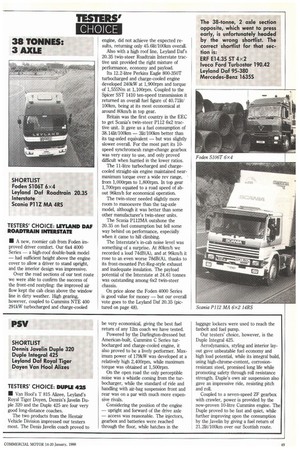TESTERS' CHOICE: INF 14.35 • We ended 1987 by roadtesting
Page 50

Page 51

If you've noticed an error in this article please click here to report it so we can fix it.
the newest 4x2 tractive unit to come on to the British market.
The Leyland Daf 95-380 bristles with the electronic gadgetry which is becoming so much a part of modern premium-weight tractive units. Its new slab-fronted Spacecab, developed in conjunction with Pegasso and mounted high on the chassis, is one of the tallest around. While the climb to the driver's seat was daunting, once inside the cab the low engine cowl made the most of available headroom across the cab width. The cab's sophisticated electronically-controlled suspension ensured a level tide under braking, acceleration and cornering and is backed up by ECAS — Daf's Electronically Controlled Air Suspension — on the chassis. This was the first vehicle we were able to test specified with ZF's compact Servocom power-assisted steering, making slowspeed manoeuvring less of a grunt.
The well-proven ATi engine and driveline combination is further improved with the single H gearshift pattern of the ZF 16S-160 16-speed gearbox.
Another first for us was our roadtest of the ERF 14.35 equipped with a production SAMT semi-automated mechanical transmission from Eaton. The beauty of this electro-pneumatic gearshift system, based on the mechanical Twin Splitter box, is that it leaves gearchanging control firmly in the hands of the driver, while relieving him of the effort of depressing the clutch pedaL Gear lever movements are replaced by those of a simple up-and-down switch. Coupled to Cummins NTE 350 turbocharged engine, the SAMT helped the ERF 14.35 to be one of the quickest 38tanners we have tested over the toughest section of our Scottish route. It was economical on fuel too, being the only 260kW-class 4x2 tractive unit to break the 401it/100km barrier.
ERF's restyled SMC plastic-panelled cab has a modern, attractive interior but the steps leading to it are narrow. Aeon voided rubber blocks with telescopic dampers at the front and coil springs at the rear gave the cab a good level ride.
Mercedes-Benz's premium cab must now be among the oldest around, but under the skin Germany's largest commercial vehicle manufacturer has continued to make improvements. Our 1635 was equipped with the electronic pneumatic power shift (EPS) gear shift system. It is not semi-automatic to the same degree as the slicker Eaton system — a switch is used to signal gearchanging, but the clutch still has to be depressed. Engagement of the gear selected seemed slower than with the basic ZF Ecosplit box, but with this model or the more powerful 1644 tractive unit you don't get a choice.
The most powerful vehicle we tested last year was the Iveco Ford Turbostar 190-42, rated at 309kW at a relaxed 1,800rpm, with massive torque output of 1,898Nm at only 1,100rpm.
Its big 17-litre vee-eight twinturbocharged engine offers even more scope for development. The high-torque concept promoted a relaxed driving style, minimising the number of gearchanges.
While the ERF 14.35 gave the best productivity it was noisier in its cab than either the Leyland Daf 95 380 or the Mercedes-Benz 1635 — but nowhere near as bad as the Iveco Ford 190-42.
It is not unreasonable to expect any premium weight tractive unit to have a restart capability of 20% (1-in-5), yet the newest of the bunch could only manage a meagre 16.7% (1-in-6).
List prices for the four vehicles in our short list range from under 240,000 for the ERF to almost 250,000 for the Leyland Daf. In this respect the ERF must represent the best value for money and is our overall testers' choice. • A new, roomier cab from Foden improved driver comfort. Our 6x4 4000 Series — a high-roof double-bunk model — had sufficient height above the engine cover to allow a driver to stand upright, and the interior design was impressive.
Over the road sections of our test route we were able to confirm the success of the front-end restyling: the improved air flow kept the cab clean above the window line in dirty weather. High gearing, however, coupled to Cummins NTE 400 291kW turbocharged and charge-cooled engine, did not achieve the expected results, returning only 45.61k/100km overall.
Also with a high roof line, Leyland Dais 20.35 twin-steer Roadtrain Interstate tractive unit provided the right mixture of performance, economy and payload.
Its 12.2-litre Perkins Eagle 800-350T turbocharged and charge-cooled engine developed 240kW at 1,900rpm and torque of 1,555Nm at 1,100rpm. Coupled to the Spicer SST 1410 ten-speed transmission it returned an overall fuel figure of 40.711it/ 100km, being at its most economical at around 801milh in top gear.
Britain was the first country in the EEC to get Scania's twin-steer P112 6x2 tractive unit. It gave us a fuel consumption of 38.141k/1001mi — 31it/100km better than its tag-axled equivalent — but was slightly slower overall. For the most part its 10speed synchromesh range-change gearbox was very easy to use, and only proved difficult when hurried in the lower ratios.
The 11-litre turbocharged and chargecooled straight-six engine maintained nearmaximum torque over a wide rev range, ' from 1,000rpm to 1,800rpm. In top gear 1,700rpm equated to a road speed of about 96km/h for economical operation.
The twin-steer needed slightly more room to manoeuvre than the tag-axle model, although it was better than some other manufacturer's twin-steer units.
The Scania P112MA outshone the 20.35 on fuel consumption but fell some way behind on performance, especially when it came to hill climbing.
The Interstate's in-cab noise level was something of a surprise. At 80krn/h we recorded a loud 74dB(A), and at 96km/h it rose to an even worse 78dB(A), thanks to its front-mounted Pet-Reg-style exhaust and inadequate insulation. The payload potential of the Interstate at 24.61 tonnes was outstanding among 6x2 twin-steer chassis.
On price alone the Foden 4000 Series is good value for money — but our overall vote goes to the Leyland Daf 20.35 (pictured on page 48).




















































































